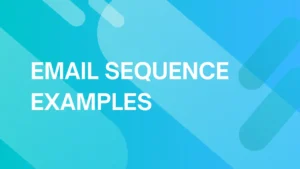
Email Alias: Definition & Uses
Using email aliases can be a powerful way to organize and manage your inbox, especially if you’re running multiple campaigns. This article explains how email aliases work and why they’re useful for streamlining communication.
You’ll learn:
- Key strategies for making the most of aliases to improve email organization and tracking across campaigns
- The benefits of using email aliases for different purposes, like separating personal and professional messages
- How to create and manage email aliases with ease

What Is An Email Alias?
As I mentioned above, an email alias is simply an email address you create under a mail server that forwards all incoming mail to another email address you own and control.
You can set up an email alias to forward to a single email address or multiple addresses depending on the situation.
In most circumstances, an email alias itself has no inbox, no login, and cannot directly be used to send outgoing emails.
Instead of emails being sent directly through an alias, all emails are directed through the primary email address that is connected to the email alias, since an alias simply will forward all activity and engagement to whichever primary email address you have associated with it.

As an example, say that johndoe@domain1.com is your primary email address that you utilize as your primary email account for your business, but you want to utilize another email address for handling certain types of email activity that wouldn’t be a fit for engaging with under your primary email address, so you create the email address info@domain1.com in order to handle this engagement.
Logging into multiple email addresses daily to check the inboxes of each of these email addresses can be a pain, so you can setup info@domain1.com as an email alias to johndoe@domain1.com so that all emails that get sent over to info@domain1.com will be automatically forwarded to johndoe@domain1.com.
What Are Email Aliases Used For?
From the example I have given previously, the intended way to use an email alias is as a forwarding system for another email address you are in control of and want to monitor alongside a primary email address you typically use.
There are a multitude of uses for an email forwarding system depending on what you are trying to accomplish as well as what type of industry you work in, but in general you utilize an email alias in order to simplify the process of checking multiple inboxes you need to monitor.
Another common use of an email alias is to simply disguise your actions online when you are engaging with other individuals. When you are utilizing an email alias, the primary email address and sender domain that is responsible for the actual email messages will not be visible to the recipient.
When you have johndoe@domain1.com as your primary email address and info@domain1.com as your alias, you can receive mail from both inboxes in the primary inbox.
Thus, making it easier to reply to all.
When you do reply, with your alias setup correctly, you can easily reply from either inbox to maintain consistency.
This allows you to essentially utilize multiple email addresses under a single email address for convenience sake.
If you are responsible for handling multiple inboxes and needing to monitor multiple inboxes for responses and engagement, you are able to do all of this under a single source environment without the hassle of having to keep multiple tabs open to check multiple inboxes.
How Do Email Aliases Affect Deliverability?
While email aliases are extremely useful for convenience sake, the issue that comes from email aliases is deliverability, and how email service providers and internet service providers view email aliases.
When you set up an email alias and send any type of email out from that alias, the recipient is only going to be able to see the email address of the alias, and have no way of identifying where this email was actually sent from.
Since an email alias does not perform any type of outreach locally, all email activity actually occurs under the primary email address you connect to this email alias.
Because of this, your email sends have a layer of anonymity when you are reaching out to a contact list if you utilize an email alias in such a way.

This is not a good practice to participate in as an email marketer.
The reason why this practice is not recommended is because when you are performing any type of outreach activity, in any sense or form whether you are performing email sends via an email sending tool or directly via the webmail clients all email service providers provide, email service providers and internet service providers keep track of which mail servers are actually responsible for sending out each and every email.
An email alias will mask the identity of the primary email address, but this does not mean that an email alias is a fix for having a sender domain with poor reputation.
If you are sending outreach under an email alias, the recipients will see the email alias as the address responsible for sending over the message but in the eyes of ESPs and ISPs, they will still see that this message was sent out by the primary email address connected to the alias and it’s associated mail server, so the sender reputation of the primary email address is what will determine inbox placement.
An email alias can actually hurt deliverability.
Having an email alias setup for an outreach campaign can be seen as being nefarious or deceptive, since you are having one inbox hiding the identity of another inbox that is performing these email sends.
If an alias is an email address under the same domain, this will also have an affect on deliverability for outreach campaigns.
While email aliases can be convenient to set up in order to handle multiple inboxes in one single place, I would not advise anyone to utilize them for cold email outreach campaigns, as it can potentially cause more issues than it is worth.
An email alias will not solve deliverability issues under a sender domain.
If you have a primary email address with poor reputation, it’s always easier and safer to register another sender domain, create email addresses under it, and then get those warmed up to build up the sender reputation.
How Do I Warm Up an Email Alias?
To put it simply, you cannot directly warm up an email alias that is actively setup as an alias.
The reason why you cannot warm up an email alias is because of the way in which aliases work, in that no actual email activity is actually occurring under the actual email alias and is instead being handled by the primary email address.
As I mentioned earlier in this article, an email alias essentially is just an email forwarding address that swaps out the sender address with that of the alias.
Because of this, all email activity actually occurs under the primary email address that is connected to the email alias.
If you were to connect an email alias to the platform, no actual warming would be occurring under the alias itself, only the primary email address you have connected to it.
If you are looking at warming up an email alias directly, it cannot be connected to a primary email address.
It needs to be performing email sends directly under itself.
Conclusion
Email aliases are an extremely useful feature that nearly all email service providers and mail server software provides to users to simplify the process of utilizing and monitoring multiple email addresses.
For the process of cold email outreach, an email alias can sometimes cause more deliverability issues than that convenience is worth.
An email alias is simply an email forwarding feature and shares all sender reputation with the primary email address you connect to it.
While it is tempting to set up multiple aliases in order to have more identities sending outreach emails, do not do it.
If you are planning on performing cold email outreach, I would advise against the use of an email alias.
| Tip: If you are preparing a wide-scale email campaign, you can book a 30-minute free consultation. |



